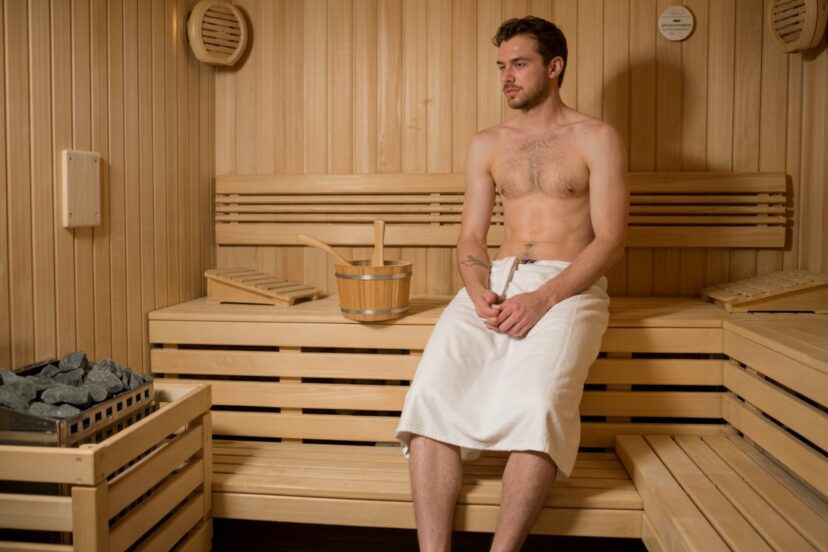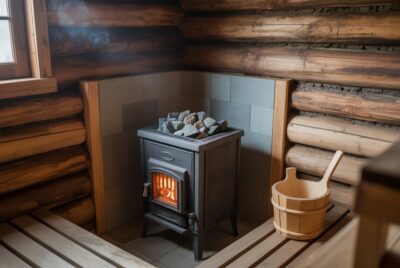What to Wear in a Sauna: Best Tips for First-Timers
*We may earn a commission for purchases made using our links. Please see our disclosure to learn more.
Steam rises around me as I push open the wooden door of the sauna, the comforting heat immediately enveloping my skin. After years of enjoying saunas across different countries and cultures, I’ve come to appreciate that what seems like a simple question—”What should I wear in a sauna?”—actually has many nuanced answers depending on where you are, who you’re with, and what type of sauna experience you’re seeking.
Whether you’re planning your first sauna visit or looking to enhance your regular sessions, choosing appropriate attire is crucial not only for your comfort but also for hygiene, safety, and respecting cultural traditions. From completely nude experiences in traditional Finnish saunas to more modest approaches in American spas, understanding sauna clothing etiquette will help you feel confident and get the most from your sweat session.
Key Takeaways
- Minimalism is traditional: Authentic sauna experiences typically involve minimal clothing to maximize sweat evaporation and skin breathing.
- Cultural context matters: Clothing expectations vary widely between countries and facilities—always research or ask about local customs.
- Hydration is essential: Regardless of what you wear, bring water and consider a moisture-wicking headband to keep sweat from your eyes.
- Natural fibers are best: If wearing clothes, choose loose-fitting items made from cotton, linen, or specially designed sauna textiles.
- Always use a towel: For hygiene purposes, sit on a clean towel regardless of whether you’re clothed or nude.
“The sauna is Finland’s sacred space—a place where the body purifies and the mind clears. What you wear—or don’t wear—is part of a tradition dating back thousands of years, where simplicity allows for the most authentic experience.”
— Dr. Marja Lahtinen, Finnish Cultural Historian and author of “Nordic Wellness Traditions,” 2022
Recommended Sauna Products
Based on my extensive sauna experiences, here are four products that can enhance your sauna sessions and help you decide what to wear in a sauna:
1. HAVLULAND Turkish Cotton Sauna Towel Set
Upgrade your beach days and outdoor adventures with the HAVLULAND Set of 4 Turkish Cotton Beach Towels. Measuring a generous 71x39 inches, these ultra-soft and absorbent towels are crafted from premium Turkish cotton to deliver both comfort and functionality. Designed to be sand-free and quick-drying, they’re perfect for the beach, pool, spa, gym, yoga, camping, or a cozy picnic. Their lightweight and compact form makes them easy to carry, while the vibrant multi-color set adds a cheerful touch to any outing. Whether you're lounging under the sun or heading to a workout, these versatile towels have you covered.
- Quick-Drying: Dries fast to keep you fresh and comfortable after water activities.
- Sand-Free Design: Shake off sand easily for a cleaner beach or picnic experience.
- Multi-Use Versatility: Ideal for beach, gym, spa, travel, yoga, and even home décor.
- Thin Fabric: Not as plush as traditional terry towels, which some may prefer.
- Color Variation: Colors may vary slightly from images due to lighting.
- Initial Shedding: May shed a bit during the first few washes.
These 100% Turkish cotton towels are perfect for sauna use, offering excellent absorbency while being lightweight enough to comfortably wrap around your body. The set includes two towels—one to sit on and one to wrap around yourself when moving between sauna rooms or cooling down. Their quick-drying properties make them ideal for repeated use during a single session.
2. Arus Men’s Organic Turkish Cotton Bath Wrap
Enjoy spa-like comfort at home or on the go with the Arus Men’s Organic Turkish Cotton Bath Wrap. Made from 100% GOTS-certified organic cotton grown in Turkey’s Aegean region, this premium bathrobe wrap features soft terry loops on both sides for superior absorbency and breathability. Its adjustable elastic waistband and secure hook-and-loop closure provide a custom fit, while the front pocket adds practical convenience. Ideal for after showers, gym sessions, saunas, or poolside lounging, this knee-length wrap combines comfort, function, and sustainability in one.
- Certified Organic Cotton: GOTS-certified Turkish cotton is gentle, breathable, and eco-conscious.
- Custom Fit: Adjustable elastic back and Velcro-style closure ensure a snug, secure wrap.
- Functional Design: Includes a handy front pocket for small essentials.
- Velcro Maintenance: Needs to be closed during washing to avoid snagging loops.
- Shorter Length: Knee-length may not provide full coverage for taller users.
- Color Selection Limits: Some color options may be unavailable depending on size.
For men seeking comfortable, modest coverage after a shower or sauna, this organic Turkish cotton bath wrap delivers both function and breathability. Designed to sit securely at the waist with an adjustable elastic band and Velcro-style closure, it offers a reliable fit without bulk. Falling to knee-length, it’s an ideal option for mixed-gender environments or communal spa settings where extra coverage is appreciated. The absorbent terry cotton wicks away moisture while allowing skin to breathe, ensuring all-day comfort.
3. Halsa Sauna Hat
Stay cool while soaking up the heat with the Halsa Sauna Hat, made from 100% natural wool for effective insulation and breathable comfort. This eco-friendly headgear is designed to shield your head and hair from the intense temperatures of saunas, steam rooms, banyas, and bathhouses. Its one-size-fits-most design ensures a cozy fit for both men and women, while the handmade construction adds a touch of rustic authenticity. Whether you’re a seasoned sauna user or new to heat therapy, this sauna hat helps regulate your body temperature so you can stay in longer and enjoy the full benefits of your wellness routine.
- Heat Protection: Shields head and hair from extreme sauna temperatures, reducing risk of overheating.
- Breathable Comfort: 100% wool fabric allows airflow while maintaining insulation.
- Universal Fit: One size fits most—no need to measure your head size.
- Care Required: Hand wash only; not dryer safe.
- Limited Sizing: May not accommodate all head sizes comfortably.
- Initial Wool Scent: Natural wool scent may be strong at first use.
This handcrafted wool sauna hat is designed with both comfort and protection in mind, making it an essential accessory for anyone who enjoys heat therapy. It shields your head from the intense temperatures of saunas and steam rooms, helping prevent overheating while preserving hair moisture. The breathable wool felt material allows airflow to keep you comfortable, and its moisture-absorbing properties help minimize sweat dripping into your face, allowing you to relax and stay in longer.
4. Traditional Sauna Slippers with USA Flag Design
Step into warmth and style with these premium felt sauna slippers featuring a patriotic USA flag motif. Made in Ukraine with meticulous attention to detail, these unisex slippers combine traditional sauna comfort with modern functionality. The non-slip, three-layer sole ensures stability on damp or smooth surfaces, while the breathable felt keeps your feet warm without overheating. Whether you're lounging at home, relaxing at a spa, or staying at a hotel, these slippers are a must-have for cozy, hygienic comfort.
- Durable Build: Three-layer felt sole offers reliable grip and comfort across various surfaces.
- Unisex & Universal Fit: Fits most men’s and women’s feet (US sizes 9–10), making them ideal for shared spaces or guests.
- Stylish Touch: USA-themed embroidery adds a unique and fun patriotic flair.
- Limited Size Range: Universal sizing may not fit those with smaller or larger feet.
- Not Machine Washable: Requires spot cleaning or gentle hand care to maintain quality.
- Indoor Use Only: Not suitable for outdoor wear due to felt material and sole design.
These non-slip wooden sandals are essential for safely navigating potentially hot or wet surfaces around saunas. They feature an ergonomic design with natural wood that stays cool to the touch and provides proper drainage. The adjustable strap ensures a secure fit when moving between sauna rooms, showers, and cooling areas.
What to Wear in Different Sauna Types
Traditional Finnish Saunas
In Finland, the birthplace of sauna culture, the traditional approach is nude bathing, often segregated by gender in public facilities. When I visited Helsinki, I discovered that Finns consider clothes or swimwear in the sauna somewhat unhygienic because they prevent proper sweating and can trap bacteria against the skin.
If you’re visiting Finland or an authentic Finnish sauna elsewhere:
- Nudity is expected and completely non-sexual
- Always sit on a towel for hygiene
- Wearing a sauna hat to protect your head from excessive heat is common
- Jewelry should be removed as metal can become uncomfortably hot
- Gender-separated sections are typical in public saunas
- Family saunas might involve swimwear or towels
American and Western Spas
In contrast to Finnish traditions, many American and Western spas take a more modest approach. During my visits to spas across the United States, I found these conventions:
- Swimwear is often required, especially in mixed-gender saunas
- Some upscale spas provide special sauna wraps or towels
- Single-gender sauna areas might allow nude bathing with a towel wrap
- Athletic facilities with saunas typically expect swimwear or workout clothes
- Hotel saunas generally follow swimwear requirements
Infrared Saunas
These modern saunas operate at lower temperatures than traditional ones but still produce significant sweating. For infrared sessions:
- Light, loose cotton clothing is often recommended
- Some practitioners suggest wearing more coverage to keep the heated areas warm
- Synthetics should be avoided as they can prevent proper sweating
- Loose shorts and t-shirts made of natural fibers work well
Russian Banyas
When I experienced a traditional Russian banya, I found they have their own distinct customs:
- Nude bathing is common but with a felt hat to protect the head
- A special bundle of birch or oak twigs (venik) is used for massage and stimulation
- Between heat sessions, bathers might wear a light robe or wrap
- Mixed-gender sessions typically involve swimwear or towel wraps
Material Considerations
The fabric of your sauna attire significantly impacts your comfort and safety. Based on my experience:
Recommended Materials
- Cotton: Breathable and absorbent, cotton allows sweat to evaporate while feeling comfortable against your skin. It’s my go-to material when clothing is required in a sauna.
- Linen: Similar to cotton but even more breathable, linen is excellent for sauna use as it dries quickly and feels cool against the skin.
- Specialized Sauna Textiles: Some manufacturers produce textiles specifically designed for sauna use, featuring quick-drying properties and heat resistance.
- Wool (for sauna hats only): Traditional sauna hats are often made from wool felt, which provides insulation to protect your head from excessive heat while allowing some breathability.
Materials to Avoid
- Synthetic Fabrics: Materials like polyester, nylon, or spandex can trap heat against your skin, prevent proper sweating, and sometimes release chemicals when heated.
- Tight-fitting Clothes: Any clothing that restricts circulation or prevents air flow can detract from the sauna benefits and cause overheating.
- Moisture-wicking Athletic Wear: While these might seem logical, many are designed to dry quickly rather than allow proper sweating and often contain synthetic fibers that aren’t ideal for high heat.
Hygiene Considerations
Maintaining proper hygiene in a sauna environment is crucial both for your health and out of consideration for others. Here’s what I’ve learned:
- Always shower before entering: Remove oils, lotions, and perfumes that can vaporize in the heat
- Sit on a clean towel: Regardless of whether you’re nude or clothed
- Bring at least two towels: One for sitting and one for drying off
- Replace wet clothing: If wearing clothes, change into dry items between sessions
- Avoid applying lotions or oils: They can clog pores and prevent proper sweating
- Remove makeup: It can melt in the heat and clog pores
Age and Gender Considerations
Sauna practices often vary based on age and gender dynamics:
Family Saunas
- Children typically wear swimwear in family settings
- Modesty wraps or towels are common in multi-generational settings
- Lower temperatures are recommended for sessions involving children
Gender-Specific Areas
- Single-gender areas often allow more flexibility in attire choices
- Women-only saunas might have specific customs regarding coverings
- Men-only settings typically have their own established norms
Mixed-Gender Facilities
- Clear signage usually indicates expected attire
- Private changing areas should be available
- Modesty is generally more emphasized than in gender-separated spaces
Cultural Variations Around the World
My sauna travels have revealed fascinating cultural differences:
Finland & Nordic Countries
- Nudity is the norm, with gender separation common
- Sauna is considered a clean, purifying space with strict etiquette
- Textile-free (nude) mixed saunas are becoming more common in progressive areas
Germany & Central Europe
- Textile-free (FKK) culture is strong in many facilities
- Mixed-gender nude saunas are common and non-sexual
- Sitting on towels is strictly enforced
- “Textile” (clothed) times may be specifically scheduled
Japan (Onsen & Sentō)
- Complete nudity is expected but gender-separated
- Small “modesty towels” may be carried but not worn in the water
- Bathing suits are generally prohibited in traditional facilities
Turkey (Hammam)
- Modesty is important; women typically wear undergarments or wrap towels
- Attendants wear specific traditional attire
- Gender separation is still common in traditional hammams
North America
- More conservative approach with swimwear often expected
- Private home saunas might follow European traditions
- Health clubs typically require some form of clothing
Etiquette Tips Based on Personal Experience
Over years of sauna use, I’ve found these practices helpful:
- Observe before participating: Take a moment to notice what others are wearing
- Ask staff about expectations: When in doubt, check with facility employees
- Bring options: Pack both swimwear and towels until you know the local customs
- Focus on your own experience: Avoid staring or making others uncomfortable
- Be prepared to adapt: Different rooms within the same facility might have different expectations
Health Considerations When Choosing Sauna Attire
Your clothing choices can impact the health benefits you receive:
- Heat tolerance: Proper attire helps you regulate body temperature safely
- Detoxification: Minimizing barriers on skin allows for better sweating
- Circulation: Tight clothing can restrict blood flow that sauna heat naturally enhances
- Breathing: Some sensitive individuals may want to protect airways with a small breathable cloth
- Skin conditions: Those with certain conditions might need specific coverings
Seasonal Adaptations
I’ve noticed my sauna preferences change with the seasons:
- Winter: More clothing before and after, with special attention to keeping warm after sessions
- Summer: Lighter preparation, with focus on proper cooling between sessions
- Transitional seasons: Greater temperature fluctuations require adaptable approaches
Conclusion
After exploring sauna cultures worldwide, I’ve come to appreciate that there’s no single “correct” answer to what to wear in a sauna. The most important factors are respecting local customs, maintaining proper hygiene, and choosing clothing options that allow your body to experience the full benefits of the heat.
Whether you opt for traditional nude bathing with just a towel, prefer a sauna wrap for modesty, or follow your facility’s swimwear requirements, the key is selecting options that allow your skin to breathe and sweat freely. Natural fibers, loose fits, and minimal coverage generally provide the most authentic experience when considering what to wear in a sauna.
Remember that true sauna culture is about wellness, not appearance. The focus should be on the restorative heat, the cleansing sweat, and the profound relaxation that follows, not on what you or others are wearing. With the right approach and appropriate attire for your context, the sauna can become a cherished wellness ritual in your life, just as it has in mine.
Frequently Asked Questions
1. Is it better to be nude or wear swimwear in a sauna?
From a purely physiological perspective, nude sauna bathing (while sitting on a towel) allows for optimal sweating and heat regulation. However, the “better” choice depends entirely on the facility’s rules and your personal comfort. Traditional Finnish saunas embrace nudity, while many Western facilities require swimwear. If allowed to choose, natural fabrics or no clothing at all provide the most authentic experience.
2. What should I bring to my first sauna visit?
For your first visit, I recommend bringing: two towels (one to sit on, one to dry off), flip-flops or sauna sandals, a water bottle, any required swimwear, a cotton robe for breaks, and a small toiletry kit for showering after. Also consider a sauna hat if you’re sensitive to heat on your head and a non-metal water bottle for hydration during your session.
3. Can I wear jewelry in the sauna?
I strongly advise against wearing jewelry in the sauna. Metal conducts heat efficiently and can become uncomfortable or even cause burns when subjected to sauna temperatures. Additionally, the constant heating and cooling can damage some jewelry materials, and stones with natural inclusions might crack. Remove all jewelry before entering.
4. How should I dress between sauna sessions?
Between sauna rounds, I find it best to wear a lightweight cotton robe or wrap a fresh towel around your body. This allows your skin to continue breathing while providing modest coverage when walking between sauna rooms, plunge pools, or relaxation areas. Your body will still be eliminating toxins through your skin, so avoid tight or synthetic materials during breaks.
5. Are there special considerations for infrared saunas versus traditional saunas?
Yes, there are differences. In infrared saunas, some practitioners recommend wearing light cotton clothing that covers the body areas you want to target, as the infrared heat penetrates directly into tissues rather than primarily heating the air. In traditional saunas, less clothing is generally better as the goal is to allow sweat to evaporate freely in the hot ambient air. Both types require breathable materials if any clothing is worn.
















